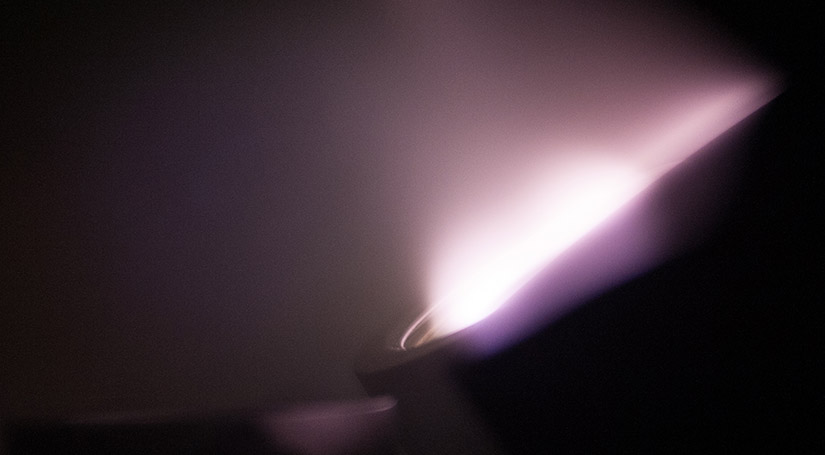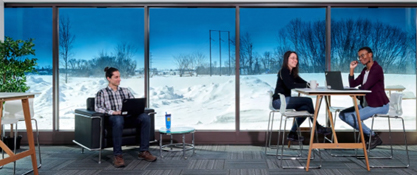Decarbonizing Windows Takes a Big Step Toward Industry Certification
Durability Validation Shifts From Lab to Industry Partner

Imagine being in a home, school, office space, or building with no windows.
In our world where windowless buildings rarely exist, the subtle significance of windows can easily be lost. Today, windows are responsible for about 10% of energy use in buildings and influence end uses that comprise 40% of building energy use.
Pioneered by the National Renewable Energy Laboratory (NREL) and developed during three decades of research, electrochromic windows are installed in buildings across the country. These windows provide an adjustable tint that allows occupants and building managers to control the amount of sunlight entering a building, helping to keep it warmer in the winter and cooler in the summer. Reduced electricity bills, improved privacy, and a better view are made possible by this window technology that spurred a new industry for U.S. manufacturing and jobs.
In a collaborative effort with industry, electrochromic technology—especially related to durability testing—has been nurtured, strengthened, and enhanced by NREL researchers like Rob Tenent and Alliston Watts. A significant milestone in this long-standing relationship is the transfer of the durability evaluations to an industry partner, QAI Laboratories, in Florida. This assessment was developed at NREL in the late 1990s and has played an integral part in the development of all dynamic glass products currently on the market.

"It's always been our intention for industry eventually to provide this valuable resource," Tenent said. "Laboratories are meant to work on innovative technologies, with the goal of then transitioning the technology to partners. We're lucky to have such a strong relationship with QAI to support their success, as they provide a needed capability to the windows and glass industry."
Windows of the Future
The U.S. Department of Energy (DOE) Building Technologies Office (BTO) has supported development of next-generation, high-performance windows to achieve low-carbon buildings. As a result of the BTO Windows subprogram's long-term support, electrochromic windows can help meet high-performance building goals by reducing annual cooling and heating loads and peak electricity demand. Electrochromic windows have the flexibility to participate in grid-interactive efficient building response capabilities by reducing peak by over 20%.
To increase its marketability, lowering the installation cost is crucial to making electrochromic windows more cost competitive for commercial and residential applications. Moving durability evaluation from the laboratory and to the private sector is an important step.
"No one in the industry currently certifies to ASTM E2141 durability," said Marc LaFrance, BTO's windows technology manager. "Transferring the testing capability to a commercial testing laboratory helps build toward an industry-recognized certification of electrochromic windows. Certification will encourage investment in window manufacturers, leading to lower production costs, lower window costs, and will help facilitate BTO's program goal of mass-market adoption."
Moving Toward Market Transformation
Many stakeholders in the development of electrochromic windows either have had or will have impactful roles to play in its journey toward market transformation. Working with multiple industry partners, the NREL team performed fundamental research into degradation modes of electrochromic windows. These studies formed the basis of the ASTM E2141 method to assess durability. NREL continued to conduct analysis of new prototype devices for additional manufacturers as required to help this market grow before sufficient demand made offering this method economically viable for commercial testing organizations. As the electrochromic window market began to expand in recent years, it was clear that sufficient growth in this area justified private sector testing laboratories making the investments needed to serve this demand.
As a result, Tenent started conversations with Bipin Shah of WinBuild USA, one of NREL's longest-standing partners in windows research, about identifying appropriate commercial testing laboratories.
As a former technical director of the National Fenestration Rating Council, Shah began a close working relationship with NREL staff on window reliability evaluation in 1996 and has worked with DOE on several projects. Shah reached out to a few contacts whose companies were well equipped to perform this test and would likely be able to invest the money and take on the challenge. He saw the move from lab to commercial testing as an important opportunity to impact the industry and move it in the right direction.
QAI, an international testing laboratory, expressed interest in the test. It was an opportunity to enhance the capability of their existing window and glass evaluation and certification services, better providing their clients with one-stop shopping. As Jose Sanchez, QAI's operations manager, noted, "Durability testing of electrochromic windows provides the manufacturer with the assurance that they are providing the marketplace with a quality product that will perform well in the field."
QAI expects to begin offering the ASTM E2141-21 test in 2022. With ongoing education, manufacturers are becoming aware that durability testing is commercially available and at a lower cost than before. More manufacturers are asking to take advantage of it. That is the certainly the case for one manufacturer, SageGlass.
SageGlass is one of the first manufacturers of electrochromic windows. They have been a long-time DOE and NREL partner in the development of this innovative window technology. The commercial availability of testing means that SageGlass' cost of testing every product iteration for durability decreases. It is anticipated that over time, those cost savings could lower the final cost of the window.
"Electrochromic durability testing and the corresponding certification is critical both to verifying the long-term performance of our electrochromic windows and for communicating that reliability to the market. SageGlass was happy to support the transfer of this test to the private sector," said Ben Treml, SageGlass quality manager.
Windows Durability Boosts Confidence and Marketability of Electrochromic Products
Achieving mass-market adoption of any new technology takes time. Increased durability testing can attract the attention of early adopters, customers who see the technology's benefits and are willing to take a risk. Electrochromic window certification is a natural next step after durability testing. Standardized certifications encourage customers who are intrigued by the innovative potential of electrochromic windows. Like the early days of light-emitting diode (LED) lights, the potential applications of electrochromic windows in building energy efficiency are limitless.
"Having certification for this type of product helps the industry give the user confidence in the product," Shah said. "It will increase the volume in the market, which in turn will bring down the cost of the product. Overall, it's a holistic cycle of making certification available to the manufacturers, adopting the certification into codes and standards, which in turn will increase the product's market share and decrease the cost of the technology."
DOE and NREL continue to work with advanced technology and innovative approaches, including new material discovery and novel technological approaches, as well as applied engineering, to address many of the performance and cost challenges faced by industry to produce highly efficient, affordable windows that can achieve mainstream market acceptance.
Last Updated May 28, 2025
